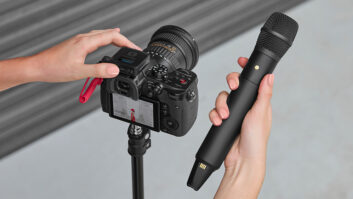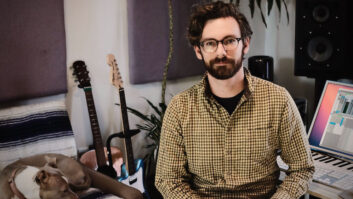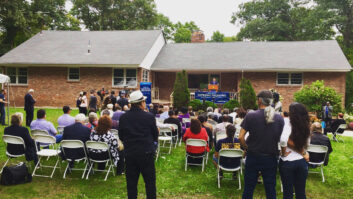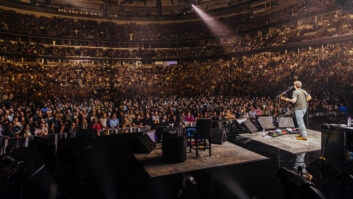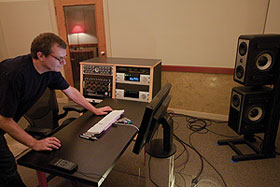
John Greenham pictured in his mastering room at 1340 Mission with his Magix Sequoia workstation and Barefoot Mastering Stack
Photo: Marsha Vdovin
San Francisco–based mastering engineer John Greenham has quietly amassed a wealth of album credits for artists in numerous musical genres. He earned Grammy recognition in 2006 and 2007 for his mastering work with Mexico’s Los Tigres Del Norte (Best Norteño Albums) and mixing work on Peruvian singer Pamela Rodriguez’s Peru Blue, for which she received a 2006 Grammy nomination as Best New Latin Artist. In 2009, Greenham moved his operations from The Annex in Menlo Park, Calif., to San Francisco’s 1340 Mission studio complex.
This month, Greenham begins the newest phase of his career in launching his new business venture based out of 1340 Mission, Essential Mastering, in partnership with engineer Robert Cross.
In this interview—which expands on the John Greenham Q&A from the Sessions section of Mix’s July 2010 issue—Greenham discusses his equipment choices, details his thoughts on the loudness wars, explains his techniques in greater detail and reflects on his career.

Greenham mastered Los Tigres Del Norte’s 2007 album Detalles Y Emociones, which won a Grammy Award for Best Norteño Album.
How did you come to join 1340 Mission?
This room became available again last year, and this is my second tour of duty here. I worked here from 2000 to 2003. Paul Stubblebine, whom I’ve known since the Rocket Lab days, built these two mastering rooms with the help of Bob Hodas. We had been working out of Studio C in the Hyde St. Studios complex and decided to go for an upgrade. I’ve always loved working in this particular room—it’s fun and easy to work in. With all the [projects that are] being done in garages and living rooms nowadays, more than ever there is a need for an accurate monitoring environment to finish projects in. I’d say all in all this is the best rig I’ve ever used for mastering.
How does your business fit into the complex?
I’m actually putting together a Website called Essential Mastering [along] with Robert Cross, a young engineer whose work I like. There will be a Website for that and then that will be part of the 1340 [complex]. The stuff’s coming out great and I want more people to know we’re here. I think it’s nice to work in a proper recording facility. A lot of big records have been made in this building. It has a good feeling about it. So far I’ve resisted following the trend of working at home.
What is your take on the loudness wars?
My job is to give people something they can feel excited about and get behind, and that will work both from a commercial as well as from an artistic point of view. For as long as people have been releasing music, whatever the medium, people on the leading edge of commercial record-making have always tried to get as much onto it as they could. When the main release format was vinyl, they wanted the vinyl cut as hot as you could possibly cut it. That’s just the reality of the world we live in. Having said that, I find that every record has a level of loudness that feels comfortable and if you go any further than that it will start sounding stressed. It varies from project to project. Some want to be loud, others don’t. Generally it’s not good to force things beyond a certain point. Getting stuff loud and clean sounding is an art form, really. Once I realized I couldn’t survive in the industry unless I followed the loudness trend, I spent a long time figuring out the best way to do it and after that I just stopped worrying about it, really.
I try to discourage people to just go for loudness. But at the same time, people on the sales end want it to be aggressive. I have two teenage daughters—who, to me, represent the record-buying public—and I see what happens with them: The music has to come out with a certain impact; if not, it’s on to the next song! So part of my job is to not let that happen to the artist if I can and the loudness is one factor in that equation. It’s better than it used to be. The technology has gotten better, I think, over the last 10 years or so. Chuck Prophet summed it up really well when we were talking recently. About level, he said, “We want to be competitive, but responsible.”

In early 2010, Greenham mastered Ceremony from pianist/composer Omar Sosa, which features Sosa’s remarkable collaboration with composer/arranger/cellist Jaques Morelenbaum and Hamburg, Germany’s NDR Big Band.
Is it now easier to keep tracks sounding good while applying compression?
I think the technology has improved greatly, especially on the digital side. A very interesting form of compression is achieved with tape, which I use quite often. The tape process deals with the transients in a very musical way. I’ll get somebody’s mixes at 44/16, I’ll hit the tape, I’ll go from the tape into the compressor if it needs any additional compression, and then I’ll capture that at 88/24. I’ll bring those files back into the workstation and they’re usually pretty close to done at that point. Basically I get the analog flavor in everything and then I make fine adjustments with plug-ins. That way, if people want changes, you don’t have to go through the entire analog process again so it’s much quicker. Fifteen years ago I wouldn’t have considered using tape in mastering. But now a lot of stuff that people are bringing is kind of flat sounding because it’s all-digital. The tape brings it to life.
What are some of your key pieces of equipment?
The Barefoot Mastering Stack speakers [manufactured by Barefoot Sound in San Francisco], which I got when I moved in here, are really pretty good. They’re very accurate in the low end. Also, they’re fun to work on. They give you a lot of music to listen to. They also translate very well, which is the Holy Grail of monitoring, really. This is probably the easiest monitoring rig that I’ve ever worked on to get good results, consistently.
The ATR 104 [2-track, 1-inch tape recorder] is a beautiful machine that has tube electronics built by Tim de Paravacini of Esoteric Audio research in England. There aren’t that many of these machines around. Bob Ludwig has one at Gateway. Sometimes I’ll just run stuff through the electronics and not even hit the tape because that has a really interesting sound all of its own. People love the sound of tape although it doesn’t work for everything. For example, in R&B, [clients] want [their tracks] to be very clean and crisp, so you wouldn’t want to put that through tape. So it’s not the universal solution for everything.
I use the Elysia Alpha compressor a lot for mastering. It’s a great box. Trust the Germans to build something like that!
My mix rig at the moment involves the Mytek [8X192 Series AD/DA converter], which is an 8-channel box that I‚’m liking quite a bit. I’ll have four stereo pairs that I split out from the workstation, and I find that that’s enough, although I might get another one of them at some point and have 16 channels. I had elaborate ideas about using lots of analog gear in mixing but I find the UAD plug-ins are pretty good, especially at 2x sample rates, and these days recall-ability is the key.
As far as the workstation goes, I like Sequoia for mastering, and I use it for mixing too. It’s very versatile, and it comes with really good plug-ins. Additionally I’ve got the CubeTec mastering plug-ins. They give you a great sound, but it’s not really a sound that’s emulating any piece of analog gear. They just really work well. Then I’ve got the UAD-2 card with all the plug-ins that emulate the analog stuff. They sound great, as I said, especially at higher sample rates.
Jeff Sheridan in Los Angeles actually built the system for me. It’s a Mac Pro with Windows and the Mac OS on it as well, so I can use either platform. I’ve been experimenting with Logic lately but I’m not all that impressed with the way it sounds. Sequoia on XP with the RME AES card sounds really good though, I think.
I’m curious about your background. How did you get to where you are now?
That’s a question that I ask myself all the time [laughs]. I think Paul Stubblebine says it best: “There’s a particular assortment of character defects that go toward making a good mastering engineer.” Seriously, though, for one thing, I was given the opportunity—by Paul, actually—to do work on some top-notch gear and that’s very important. Your work is only going to sound as good as the gear you’ve got.
I also played music for many years. I know what it’s like to stand on a stage with a Marshall half-stack and a Les Paul, and what that’s supposed to sound like and how the audience reacts to it. That helps. I feel that I understand music, and that is how I’m able to do my job. I’ve also done a lot of recording and mixing and I like many different kinds of music. What I try to do in here—with whatever kind of music it is—is to try to make it exciting so that people will be moved when they hear it.
How did you end up choosing mastering as your favorite part of the music production process?
One thing I found interesting right away was how with one very small EQ move you could open up the whole program. It’s quite magical, really. You do very small but precise things in mastering that have a big effect.
There isn’t really any sort of career path for it any more. Again, it’s probably good if you’re a musician and I think it really helps to understand recording and mixing. Originally mastering was basically putting music onto the release format in a way that would work from a manufacturing point of view. Back in the ’60s, the first thing you learned [if it was felt you showed promise as an engineer] was how to fit the stuff on the medium appropriately, and then after a couple of years of that, they would put you back into recording and mixing and you’d have an understanding of the parameters of the whole thing. For that reason it was known as “transfer” back then. Then certain people started pushing the envelope in mastering: more low-end, more level. There’s that loudness thing again. They became known for their sound, and became independent. These days there isn’t that framework to bring someone along, though.
What have you learned as a mastering engineer?
I think one of the most important things is to send people on their way with a product they can be excited about and proud of. That way they leave with added momentum to go onto the marketing/promotion phase. Also whatever you did on the last record that worked really well, don’t try and do it on the one that’s coming in the door [laughs], because sometimes if something works really well you tend to want to use it again because it’s your new thing, but it’s probably not going to work a second time. You just have to rely on your instincts and your aesthetic sense to figure out how to help the music to be more engaging and exciting and clear your head of any preconceptions. When you get there you also have to know when to stop as well!
Sometimes I refer to mastering as closure. People come in and in some cases they’ve been working on these records for years, in various parts and bits and pieces, and then they finally got their nerve up and put it all together and they bring it to you, and then you hand them the CD, and what you’re really saying is, “It’s done! It’s finished; now you can move on with your life! [Laughs] Now you can start working on the next record.” In the end the clients rely on you to tell them the process has reached a successful conclusion. They listen to you because you’ve been down that road so many times before. It gives them the confidence to move on.
All aspects of record making are a constant learning process. Essentially, with the music we are given, we are just trying—as [composer/pianist/percussionist] Omar Sosa said‚—to find the beauty in it. And the beauty is not necessarily melodious; there’s beauty in ugliness, too, if that’s what the idea is. As a mastering engineer, first and foremost you’ve got to get behind the music and the artists vision, you’ve got to love it and feel passionately about it otherwise it won’t work very well, and ultimately allow it to speak directly to the audience, and get all the technical stuff out of the way.
Matt Gallagher is an assistant editor at
Mix.



